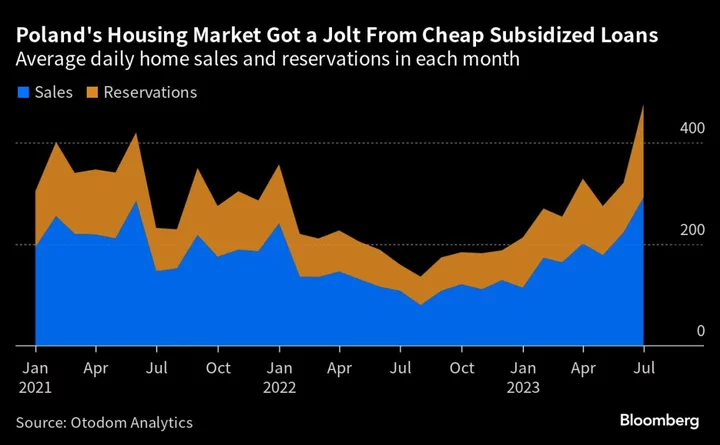Polish housing prices are expected to rebound after the government began offering subsidized mortgages to counter surging financing costs.
Atal SA, Poland’s second-biggest listed homebuilder, sees prices rising at least several percentage points as demand surges following the introduction of state-backed 2% loans on July 3. While it’s too early for firm data, rates for smaller apartments have jumped close to 800,000 zloty ($201,400), the upper limit for the mortgages, according to local media.
“The program allowed many clients that were blocked from taking mortgages at high interest rates to get financing,” said Angelika Klis, Atal’s board member in charge of sales and marketing. “If the revival continues, developers will react by raising prices.”
Affordable housing has been a hot-button issue in Poland, especially as the influx of Ukrainian refugees swelled demand for accommodation. The ruling Law and Justice party has taken numerous steps over the past year to counter surging costs, including a mortgage payment holiday. Ahead of parliamentary elections in October, Civic Platform — the biggest opposition party — aims to one-up its rival, proposing an interest-free mortgage program for first-time buyers.
Before the latest program, banks had restricted home loans amid concerns about potential defaults. Poland’s mortgage market is dominated by floating-rate loans, which means households were hit directly by rate hikes. Before the loan subsidies, new mortgages were on track for the lowest level since 2005.
Read More: Poland’s Mortgage Gloom Deepens With Loans Set for 18-Year Low
The cheap financing could set Poland up for an early recovery in home prices, while other European markets continue to adjust to higher interest rates. In neighboring Germany, home prices fell the most in more than 16 years in June.
After the new mortgage program began, thousands of Poles began submitting applications for the 10-year, fixed-rate loans. Conditions and fees vary by bank and can increase the costs, but they’re still much cheaper than the market average of 8.7%. To handle the influx, most banks have deployed additional staff, but credit intermediaries report that more applications were filed than lenders could process.
Within the first two weeks, average daily sales and reservations were on highest levels in over two years, according to the data collected by Otodom Analytics.
The demand surge is expected to help the construction industry. The Warsaw WIG Real Estate index — which reflects share prices of 22 developers, mostly homebuilders — has surged 46% so far this year.

